The official currency of Belize is the Belize dollar (BZD), which is divided into 100 cents. The BZD is pegged to the US dollar at a rate of BZD 2 to USD 1.
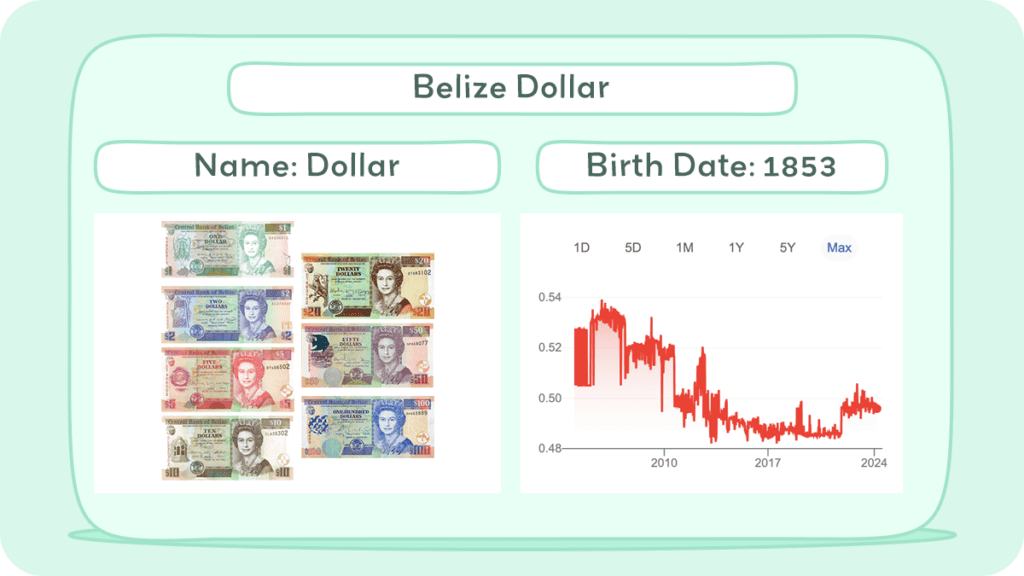
The Belize currency has a long and fascinating history. From its early days as legal tender in the 18th century to its current status as the official currency of Belize, the Belize dollar has undergone many changes.
This article examines the Belize dollar, the official currency of Belize. It explores the history of the Belize dollar, from its early use of various currencies to its current form and interesting facts surrounding it.
Historical Journey of Belize Currency
Belize’s currency has a rich history that dates back to the 18th century. The earliest law about currency in Belize was passed on June 19, 1784, when the Jamaica currency was established as a legal tender.
This law was enforced for sixty years. In 1849, the copper coin of the United Kingdom was declared legal tender, and in 1853, the Superintendent of the colony, Sir William Stevenson, introduced a new currency system. This system was based on the silver standard, and the Belize dollar was introduced as the official currency of Belize.
During the 19th century, the Belize dollar was pegged to the British pound, and it remained this way until 1949 when the peg was changed to the US dollar.
In 1978, the Belize dollar was pegged to a basket of currencies, including the US dollar, the British pound, and the Canadian dollar. This pegging system was introduced to stabilize the Belize dollar and protect it from fluctuations in the foreign exchange market.
In 1974, the Belize dollar replaced the British Honduras dollar as the official currency of Belize. This transition coincided with Belize’s journey to independence, achieved in 1981. The Belize dollar is now the official currency of Belize and is divided into 100 cents.
Over the years, the Belize currency has undergone several changes. In 1980, a new series of banknotes was introduced, which featured the portrait of Queen Elizabeth II on the front.
In 2011, another new series of banknotes was introduced, which featured the portraits of Belizean heroes and national symbols. These banknotes were designed to reflect Belize’s cultural diversity and rich history.
History of Coins
In 1825, the British government attempted to standardize the currency across its colonies by introducing sterling coinage, setting an exchange rate that undervalued the Spanish dollar, leading to the initiative’s failure. Corrective measures in 1838 fixed the exchange rate but didn’t apply to British North America due to local unrest.
Some colonies like Jamaica, Bermuda, and British Honduras chose to unofficially use a more realistic exchange rate, which eventually became official, making the British shilling a quarter of a dollar.
British Honduras moved to a currency based on the US dollar in the late 19th century, diverging from other British West Indies due to the silver crisis and trade patterns. This shift was formalized with the introduction of coins in 1885 and banknotes in 1894, pegging the currency to the US dollar.
The UK’s abandonment of the gold standard in 1931 and subsequent devaluation of the pound in 1949 affected British Honduras, which had its currency pegged to the US dollar, leading to protests and a devaluation of the British Honduran dollar.
Further adjustments followed the devaluation of the sterling in 1967, eventually stabilizing the Belize dollar at BZ$2 = US$1 in 1978, a rate that persists.
Coinage in Belize began with bronze cents in 1885, followed by silver denominations, and saw various compositional changes through the 20th century, reflecting broader trends in colonial and global monetary practices.
The introduction of cupronickel and later aluminum coins, alongside a decagonal 1-dollar coin in 1990, marks the evolution of Belize’s currency to meet economic needs and maintain relevance in a changing world.
History of Bills
From 1894 to 1976, the Board of Commissioners of Currency in British Honduras, later renamed Belize in 1973, issued banknotes in various denominations, including the introduction of 20-dollar notes in 1952 and the cessation of 50 and 100-dollar notes after 1928.
A new series featuring the name Belize came out in 1974. In 1976, the Monetary Authority of Belize took over note issuance, releasing a 100-dollar note in 1980.
The Central Bank of Belize, established in 1982, issued its first notes in 1983 and reintroduced the 50-dollar note in 1990, while the 1-dollar note was last issued that same year before being replaced by a coin.
In 2012, a $20 commemorative note was issued to celebrate the Central Bank’s 30th anniversary, featuring the jabiru stork and the Central Bank’s headquarters. All banknotes from the Central Bank of Belize prominently feature the late Queen Elizabeth II.
Inflation and Buying Power of Belize Currency

If you’re planning to visit Belize or invest in its economy, understanding the country’s inflation rate and the buying power of its currency is essential. Inflation is the rate at which prices of goods and services increase over time, and it affects the purchasing power of a currency.
According to data from The World Bank, Belize’s inflation rate has fluctuated over the years. In 2022, the inflation rate was 1.7%, which is relatively low compared to other countries in the region. This means that the prices of goods and services in Belize are increasing at a slower rate than in previous years, which is good news for consumers.
The buying power of the Belize dollar is also affected by its exchange rate. The Belize dollar is pegged to the US dollar, which means that its value is tied to the value of the US dollar. As a result, changes in the US economy can affect the value of the Belize dollar.
In terms of buying power, the Belize dollar is weaker than the US dollar. As of March 2024, one US dollar is equivalent to two Belize dollars. This means that goods and services in Belize may be relatively more expensive for visitors from countries with stronger currencies. However, a weaker currency can also make Belize’s exports more competitive, which can boost the country’s economy.
Overall, while Belize’s inflation rate is relatively low, its exchange rate and weaker currency may affect the buying power of its currency. It’s important to keep these factors in mind when planning a trip to Belize or making investments in its economy.
Belize dollar
1 dollar
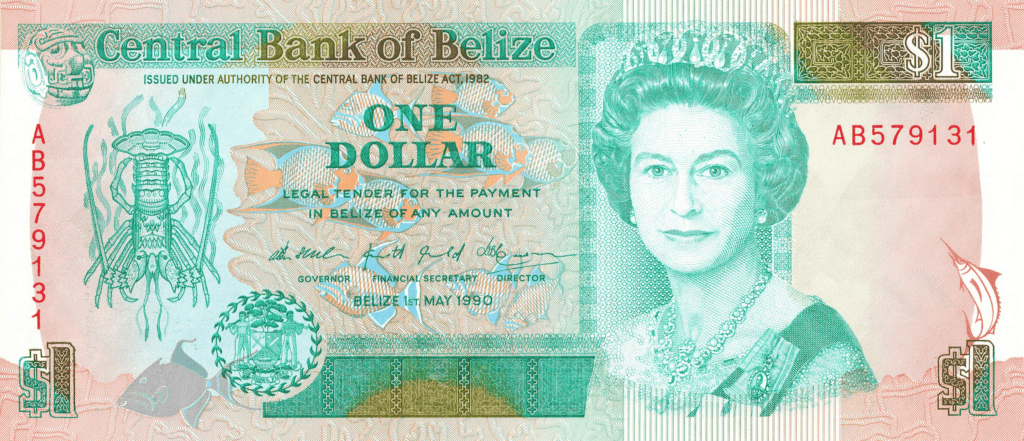
The 1 Belize dollar banknote features the Front-facing bust of Queen Elizabeth II wearing the Vladimir Tiara at centre right on the obverse and the underwater reef with star coral on the reverse.
2 dollar
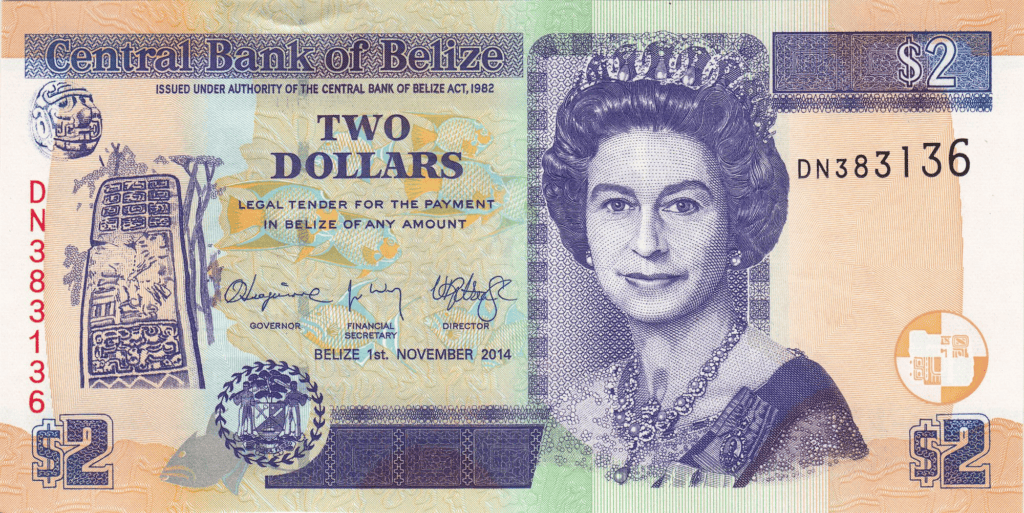
The 2 Belize dollar banknote features the Front-facing bust of Queen Elizabeth II wearing the Vladimir Tiara at centre right on the obverse and the Istoriya Ruins of Lubaantun at right on the reverse.
5 dollars
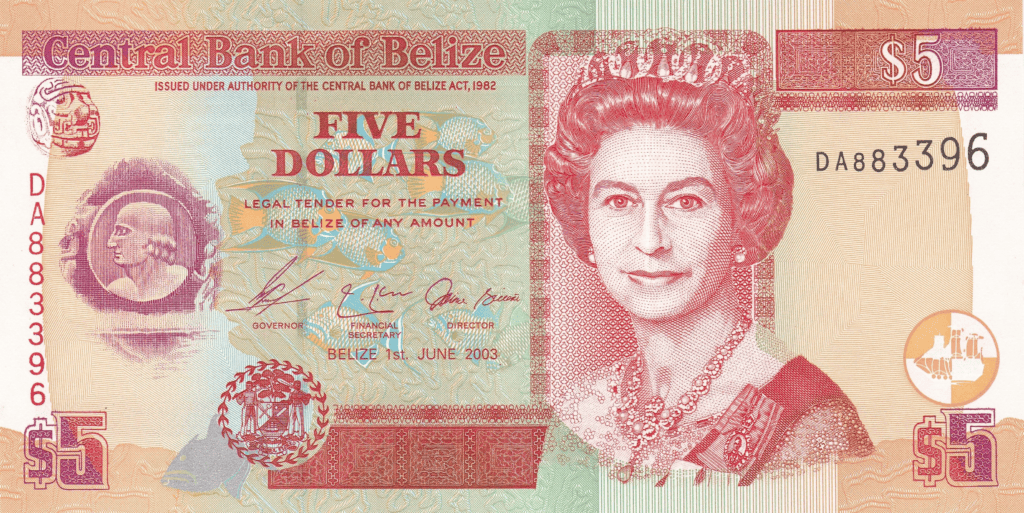
The 5 Belize dollar banknote features the Front-facing bust of Queen Elizabeth II wearing the Vladimir Tiara at centre right on the obverse and Bathing kraal and cannon at left, summer residence on the reverse.
10 dollars
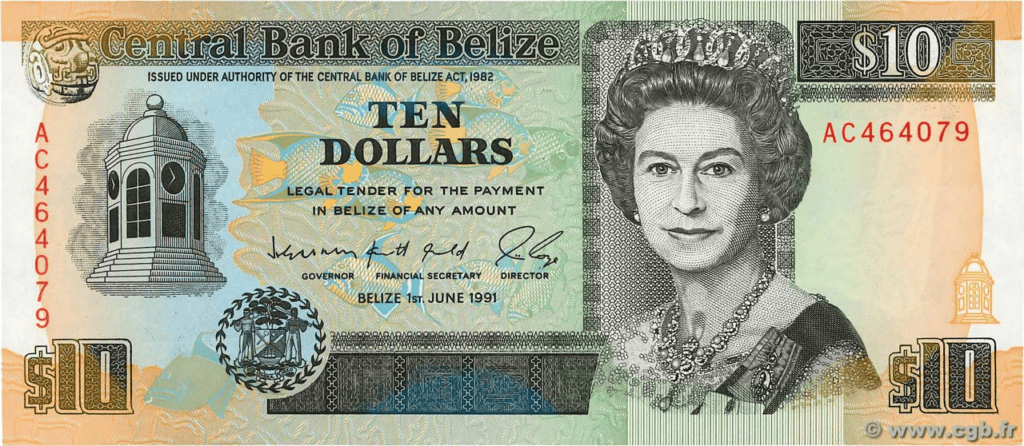
The 10 Belize dollar features the Front-facing bust of Queen Elizabeth II wearing the Vladimir Tiara at centre right on the obverse and the Government House and CourtHouse at centre, St. John’s Cathedral at right on the reverse.
20 dollars
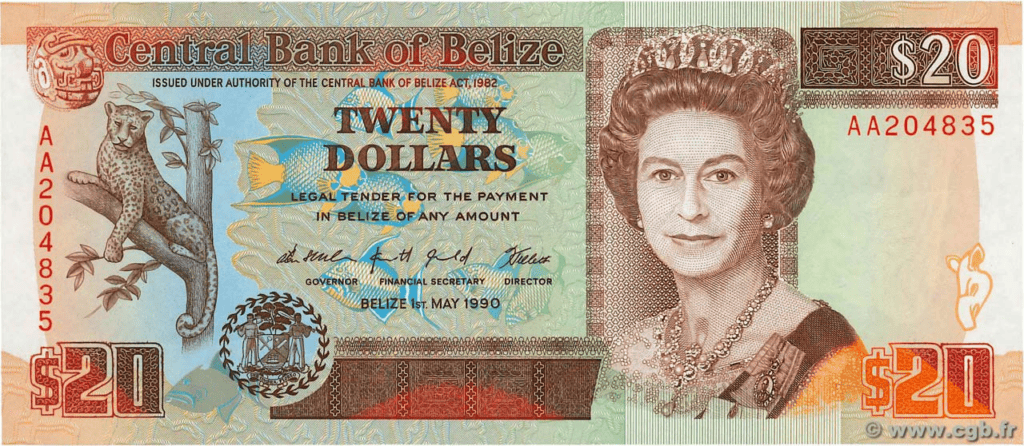
The 20 Belize dollar features the Front-facing bust of Queen Elizabeth II wearing the Vladimir Tiara at centre right on the obverse and the Neotropical fruit bat (Artibeus sp.), kinkajou (Potos flavus), howler monkey on the reverse.
50 dollars
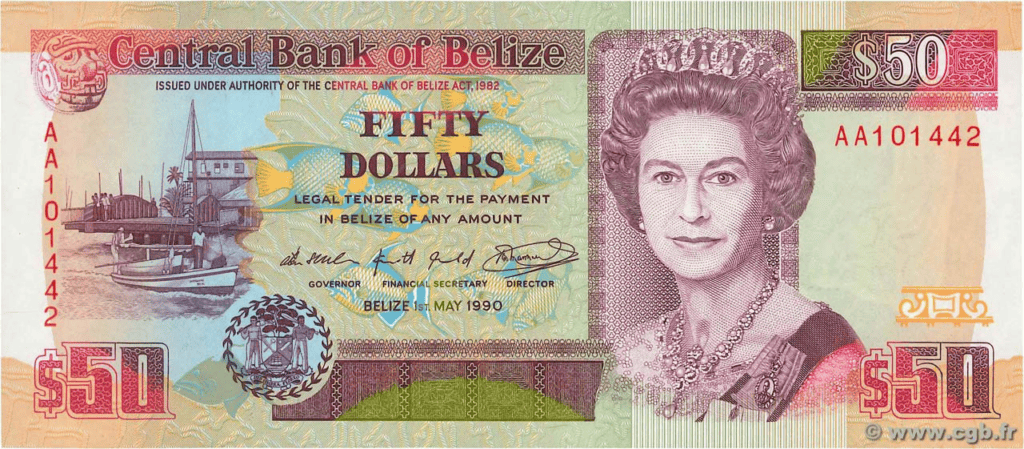
The 50 Belize dollar features the Front-facing bust of Queen Elizabeth II wearing the Vladimir Tiara at centre right on the obverse and the Belize City Swing Bridge at centre on the reverse.
100 dollars
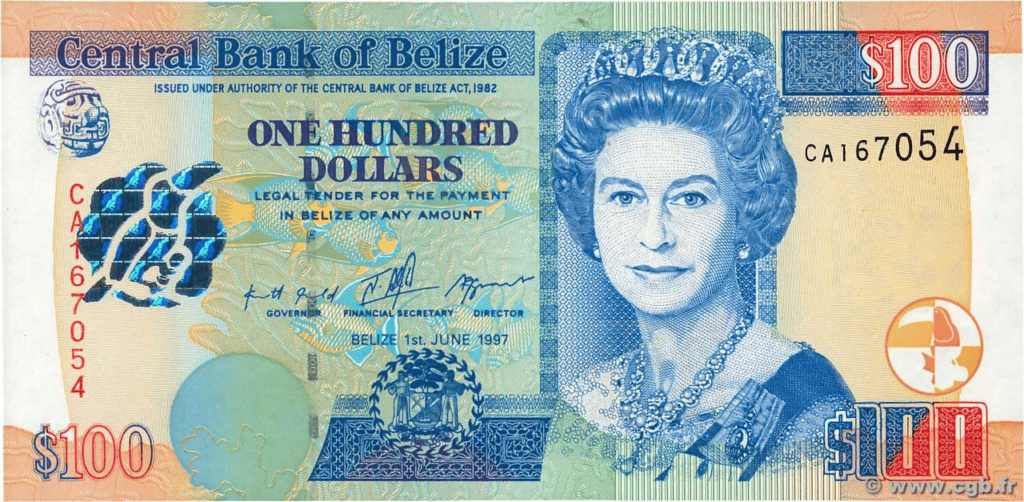
The 100 Belize dollar features the Front-facing bust of Queen Elizabeth II wearing the Vladimir Tiara at centre right on the obverse and Jabiru stork (Jabiru mycteria), brown pelican (Pelecanus occidentalis), red-footed booby (Sula sula) at centre on the reverse.
Currency Usage in Belize
If you’re planning a trip to Belize, it’s important to understand the country’s currency system. The official currency of Belize is the Belize Dollar (BZD), which is divided into 100 cents.
You can exchange currency at most banks and hotels, and ATMs in Belize usually accept foreign cards. Additionally, many businesses accept US dollars. MasterCard, Visa, and AMEX are widely accepted.
Is USD accepted in Belize?
Yes, US dollars are usually accepted everywhere in Belize. However, expect to get local currency back in change. Also, take notice that only US dollar bills, not coins, will be accepted in Belize.
While the Belize dollar is the official currency of the country, it is pegged 2-to-1 with the US dollar. As a result, businesses and locals accept US dollars without any issue. It’s essential to have some Belizean dollars on hand for small purchases, tips, and transportation.
In conclusion, understanding the currency usage in Belize is essential for any traveler. You should always have some Belizean dollars on hand for small purchases, tips, and transportation, but US dollars are widely accepted. By keeping this information in mind, you can ensure a smooth and stress-free trip to Belize.
Exchanging Currency in Belize
If you are planning a trip to Belize, it’s important to know how to exchange your currency. Here are some tips to help you exchange your money in Belize.
Where can I exchange Belize currency?
You can exchange currency at most banks and hotels in Belize. Banks and larger hotels are the safest and most secure places to exchange money. ATMs in Belize usually accept foreign cards, so you can withdraw cash from an ATM if you need to. Additionally, many businesses accept US dollars. MasterCard, Visa, and AMEX are widely accepted.
One of the advantages of using the Belize dollar is that you won’t have to worry about exchange rates if you’re coming from the United States. However, if you’re coming from another country, you’ll need to exchange your currency for Belize dollars.
You can do this at banks, exchange bureaus, or at the airport. It’s a good idea to exchange some money before you arrive in Belize, so you have cash on hand for taxis, tips, and other small purchases.
While credit cards are widely accepted in Belize, it’s always a good idea to have some cash on hand, especially if you’re traveling to more remote areas. ATMs are available in most towns and cities, but they can be harder to find in rural areas. Keep in mind that some ATMs may charge a fee for withdrawals, so it’s a good idea to check with your bank before you travel to Belize.
What to know before exchanging currency in Belize
Before exchanging your currency, it’s important to know a few things. First, the official currency of Belize is the Belize Dollar (BZD; symbol BZ$).
The exchange rate is hard pegged to the US dollar at a fixed rate of BZ$2 to US$1. Second, be aware of the exchange rate to avoid being shortchanged. You can check the current exchange rate online or at a bank.
Third, bring clean, crisp bills because some places may not accept damaged or torn bills. Finally, be sure to keep a record of your transactions in case you need to dispute any discrepancies.
In summary, exchanging currency in Belize is easy and convenient, but it’s important to know where to exchange your money and what to expect before doing so. By following these tips, you can ensure that you have the cash you need for your trip to Belize.
Choosing Between USD and Belize Currency
When traveling to Belize, you may wonder whether you should use USD or Belize currency for your transactions. Here are some factors to consider before making your decision.
Exchange Rate
The official currency of Belize is the Belize dollar (BZD), which is pegged to the US dollar at a fixed rate of BZD 2 to USD 1. This means that you will get a better exchange rate if you use USD instead of BZD.
However, keep in mind that some businesses may have their exchange rate, so it’s always a good idea to ask before making a transaction.
Convenience
While USD is widely accepted in Belize, it’s not accepted everywhere. Some smaller businesses may only accept BZD, so it’s always a good idea to carry some local currency with you.
Additionally, if you’re using USD, you may receive a change in BZD, which can be confusing if you’re not familiar with the exchange rate.
Fees
When using USD in Belize, you may be charged a higher exchange rate or additional fees. Some businesses may even charge a fee for accepting USD. On the other hand, if you withdraw BZD from an ATM using a foreign card, you may be charged a foreign transaction fee by your bank.
Tips
It’s customary to tip in Belize, and it’s best to tip in BZD. This is because some businesses may not accept USD for tips, and if they do, they may give you a change in BZD. Additionally, tipping in local currency shows that you respect the local customs and culture.
Overall, whether you use USD or BZD in Belize depends on your personal preference and the situation. It’s always a good idea to carry both currencies with you, so you can be prepared for any situation.
Cost of Living in Belize
If you are planning to move to Belize, it is important to understand the cost of living in the country. Belize has a relatively low cost of living compared to many other countries, especially in North America and Europe.
The economy of Belize is largely based on agriculture, tourism, and offshore banking, which means that living expenses can be quite affordable.
Housing costs in Belize vary depending on the location, size, and type of accommodation. You can find apartments, condos, and houses for rent or sale in Belize.
According to Numbeo, the cost of rent can range from $300 to $1,500 per month depending on the location and the size of the apartment. If you are looking to buy a house, the cost can range from $50,000 to $500,000 depending on the location and the size of the house.
Food and groceries in Belize are generally affordable. The cost of food and groceries depends on the location and the type of food you are buying. Local produce and seafood are generally cheaper than imported goods. You can expect to pay around $3 to $10 for a meal at a local restaurant, while a meal at a more upscale restaurant can cost around $20 to $30.
Transportation costs in Belize are generally low. You can get around Belize by bus, taxi, or rental car. The cost of a bus ride is usually around $1 to $2, while a taxi ride can cost around $10 to $20 depending on the distance. If you plan to rent a car, the cost can range from $50 to $100 per day depending on the type of car and the rental company.
Healthcare in Belize is generally affordable. There are public and private healthcare facilities in Belize. The cost of healthcare depends on the type of treatment and the facility you choose. The cost of a doctor’s visit can range from $20 to $50, while the cost of a hospital stay can range from $100 to $500 per day.
Overall, the cost of living in Belize is relatively low compared to many other countries. With affordable housing, food, transportation, and healthcare, Belize can be a great place to live for those looking for an affordable lifestyle.
Don’t Get Scammed Tips
When traveling to Belize, it’s important to be aware of the local currency and how to avoid scams. Here are some tips to help you avoid getting scammed while handling your money in Belize.
1. Know the exchange rate
The Belizean dollar is pegged to the US dollar at a rate of 2:1. This means that two Belizean dollars are equal to one US dollar. This will not change unless the country stops pegging the Belize dollar to the US dollar.
2. Be cautious when exchanging money
It’s best to exchange money at a bank or an authorized exchange bureau. Avoid exchanging money on the street or with individuals who approach you offering to exchange money. These individuals may offer a better exchange rate, but there’s a high chance that they are scamming you.
3. Count your change
When paying with cash, always count your change before leaving the establishment. Some vendors may try to shortchange you, especially if they notice that you are a tourist.
4. Use credit cards wisely
Using a credit card is a convenient way to pay for things in Belize, but it’s important to use it wisely. Only use your credit card at reputable establishments and avoid using it on the street or in small shops. Also, keep an eye on your credit card statements to ensure there are no unauthorized charges.
5. Avoid ATM scams
ATM scams are common in Belize. Always use an ATM located inside a bank or a reputable establishment. Avoid using ATMs located on the street or in remote locations. Also, cover the keypad when entering your PIN to prevent anyone from stealing your information.
By following these tips, you can avoid getting scammed while handling your money in Belize.

